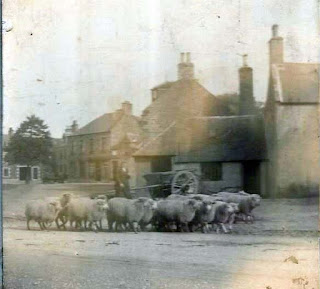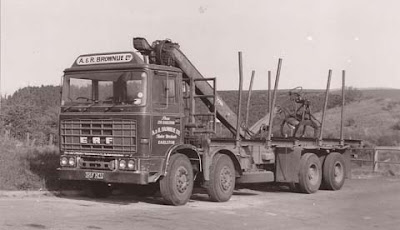 |
| Plaque on the gates to the park at Mill Meadow |
Two plaques around the village acknowledge the generosity of Isabella Wallace. Hearsay also spoke of the fact that Isabella Wallace had died in the 1920's, leaving money to be used for local projects.
This struck me as a straightforward local history challenge, but it proved to be not quite as easy as I thought.
I began the search on the family history site ScotlandsPeople website and immediately hit a stumbling block - there were three Isabella Wallaces in Earlston during the late 19th century. But which one was the village's generous benefactor? I set out to trace the family of each Isabella.
(1) Isabella
Wallace , born 20 Jan 1850 to Henry Wallace
(Master Shoemaker) and Elizabeth Swan.
In the 1851 census, young Isabella was with her parents and
brother David. But ten years later her father was a widower with three children
at home - David, Robert and daughter Elizabeth.
Their mother had died in 1857, aged 32.
Isabella was with her widowed aunt Helen Mercer and her cousin William
Mercer. In the 1871 census, Isabella,
described as "companion", was still living with her aunt, and following
her death, she became housekeeper to her cousin William.

Isabella remained single all her life and died 20th March 1927. It is important to note that, unlike their English equivalent, Scottish death certificates give the name of the parents, so I knew here that I had traced the death certificate of the Isabella who was daughter of Henry and Elizabeth - and not the other Isabella Wallace's in Earlston at this time. She was buried in Earlston Churchyard (right).
To my delight I discovered she had left a will - surely an indication of money to leave to relatives and charitable causes!
Wills provide such a wealth of information for family historians with bequests to family members, here notably nieces and nephews and sisters in law: - to "my nephews Thomas Wallace and Robert Swan Wallace, and niece Ruth Wallace, all children of my deceased brother David Wallace".......to my brother Robert Swan Wallace, draper, Paisley....to Janet Ross or Wallace, wife of the said Robert Swan Wallace" .
The will also confirmed that "the late William Mercer, draper, Earlston, bequeathed all his estate heritable and moveable to me". So here was confirmation of the source of Isabella's wealth.
Specific bequests highlighted what were regarded as important possessions - "my eight day clock.....my silver tea set...... my best china tea service.......my cream jug ....my next best china tea service....my piano...... half dozen silver spoons, sugar spoon, silver sugar sifter and tongs.
Of course primarily I was looking for an indication of money left to the parish. But the only reference was to some shares in Earlston Corn Exchange Company, with the income to be used in "keeping the burial ground and tombstone in Earlston Churchyard in order". It seemed that, despite my initial high hopes. this Isabella may not be the benefactor I was looking for.
(2) Isabella Wallace, born 18th November 1850, to George Wallace
(Innkeeper at the Commercial Inn) and Agnes Hudson.
In the 1851 census, the young Isabella was with her parents, older brother William and one servant. By 1861 the family had grown further with siblings, Helen, Agnes, John and George, to be later joined by Elizabeth and Janet - a family of eight in seventeen years. All the family were still at home in 1871.
In the 1851 census, the young Isabella was with her parents, older brother William and one servant. By 1861 the family had grown further with siblings, Helen, Agnes, John and George, to be later joined by Elizabeth and Janet - a family of eight in seventeen years. All the family were still at home in 1871.
Isabella
could not be traced
in the 1881 census and could well have married by this time - or died.
but I was unable to trace any entries in the Scottish records. So I
discounted this Isabella in my search for Earlston's benefactor.
(3) Isabella Wallace, born
c.1854, to John Wallace (master joiner) and Martha Stewart Brown.
I was unable to trace a birth or baptism record for Isabella - this was surprising, as although compulsory registration in Scotland was not introduced until 1855 (1837 in England & Wales), the practice was becoming more and more prevalent in the lead up to that date.
In 1861, Isabella,
aged 7, was with her parents and
siblings in Market Square, Earlston - John 18, Robert 14, Hannah 12, Janet 10, George 5 and Francis 1,
plus Mary Brown (mother in law). Her father John was described as a master joiner employing 3 apprentices.I was unable to trace a birth or baptism record for Isabella - this was surprising, as although compulsory registration in Scotland was not introduced until 1855 (1837 in England & Wales), the practice was becoming more and more prevalent in the lead up to that date.
 |
| Earlston's Market Square c.early 1900's |
Isabella died 2nd June 1920, with the informant her niece Agnes and her parents confirmed as John and Martha. Again to my delight I traced a will on ScotlandsPeople.
The will left heritable property "to Wilfred Wallace, residing in America, son of my late brother Frank"; "to Agnes Waddell Wallace, daughter of my late brother John my whole household furniture, every kind of wearing apparel and jewellery and all personal articles" plus a legacy of £50 per annum"; "to Janet Fairbairn Wallace, daughter of my late brother Robert £100"; "to Martha Stewart Brown Wallace, daughter of my late brother John - income from investments".
The residue of Isabella's estate, she bequeathed to the Royal Infirmary of Edinburgh.
But notably - the sum of £3250 was left to Earlston Parish Council "For the purpose of improving the amenities of the Town of Earlston including footpaths, paving, and lighting, and similar objects".
I had identified the correct Isabella!
A visit to the Heritage Hub at Hawick was called for, where I consulted the unique material not easily available elsewhere.:
- Berwickshire County Council - West District Minutes
- Berwickshire County Council Finance Committee Minutes
- Earlston Parish Council Minutes
- Earlston Lighting and Scavenging Account
In the years I looked at, the records
confirmed that the Isabella Wallace Fund was used for the provision of lighting, the upgrading of the Square, with railings around the
War Memorial, the removal of an air raid shelter, and a gateway and railings at the riverside park at Mill Meadow.
The pump and horse well on the right were demolished in 1920 to make way for the erection of the War Memorial.  | |||
To the right of the War Memorial can be seen a small plinth
which features the plaque (below) to Isabella Wallace - benefactor of Earlston |
A poignant story is linked to Isabella's decision to grant this money to her home village. Local anecdotes recall that her father's home and business in the Market Square was devastated by a fire. Local people rallied round with great generosity to help the family - something that Isabella never forgot.
Isabella Wallace repaid this through her will. to become "Earlston's Friend and Benefactor"
With thanks to the Auld Earlston Group and its associated website Lost Earlston
for the old photographs of the village.































